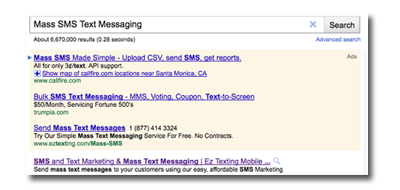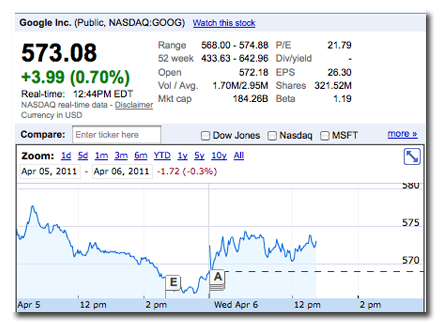Wednesday, April 6, 2011
By Dinesh Ravishanker
by Dinesh Ravishanker A lot has been said about the value of position preference in Adwords. Our Marketing Director (Kim) and I have differences in opinion of the value of Google’s position preference feature for search campaigns. I think it’s important, and she doesn’t. For those that don't know, this feature allows advertisers to set a display range for ad positions on the Google search results page. For example, if you were to search for “Mass SMS Text Messaging”, you may see this:
CallFire, Trumpia and EZTexting appear as the top 3 bids. Lets assume that EZTexting sets a position preference of [1 to 3]. If another advertiser bids higher than EZTexting's max bid, without an automated rule, EZTexting's ad may not appear again until their own bid is raised greater than the other 3. This saves the advertiser money if they have a lower conversion rate at lower positions. In my experience, position preference is also an easy way for advertisers to build brand associations with certain keywords, at a price the advertiser is willing to pay. This may not be what the feature was intended for, but now advertisers must jump through various hoops to replicate the same behavior. Advertisers may even have to use “automated rules” - a feature that does a lot, but is most often advertised as a tool to increase bids automatically. Google hasn’t stated what percentage of users are likely to see an increase in campaign spend, but I'm hopeful that our conversions will increase regardless, as Google's Chief Economist, Hal Varian, expects. So why would GOOG remove the feature? After all, changing a user’s experience usually makes for angry users. And who worse to make angry than online marketers? My guess is that this change had two drivers: simplicity and profitability. By disallowing position preference, Google’s algorithm is increasingly simple - your ad shows wherever its bid takes it. Reducing algorithm complexity could be a competitive advantage and can inexplicably create greater efficiencies. The second driver, as is for most public companies, is profitability. This announcement came shorty after Q1’s end. And since Google must please its shareholders, my hunch is that Google's Chief Economist, Hal Varian, had the luxury of running advanced statistical modeling and some fancy regression testing to determine that killing this feature would have an immense impact on Google's bottom line. I’m guessing Google’s Q2 2011 earnings will show serious growth. Google’s stock price jumped a tad after the announcement, but nothing noteworthy as of yet.
Reactions from Marketers Brad Libby comments on SearchEngineLand’s article, “Quality Score calculations account for position. An ad’s position does not affect your QS, even if reducing the position [lowers a campaign’s] CTR," in support of rescinding position preference. Google is likely to see an increase in available ad volume for any given search query. By reducing display restrictions the set of ads that can be displayed will likely increase, especially if advertisers don’t jump on the automated rules feature. This change also offers users a less cluttered user experience. April Riddle’s comment on SearchEngineLand’s article: “Usability studies have shown within those zones where the eyes move, and they are to positions 1-4. There is no amount of crack you could have me smoke and expect to believe my ad will perform as well in position eight as it does in the coveted 1-4. Now I have to set up rules and hope they work, but if they don’t I have no guarantee my ad simply will not show if it is not in the coveted spot... I will have more impressions coming without position targeting, and thus lower [CTR rates]." Obviously, April isn't so happy with the change. What can advertisers do? a) Lower your bids. This will likely save advertisers money but will decrease overall conversion rates (assuming Hal’s right). b) Setup Automated Rules. (here's how) These guys let you make bid & budget changes to keywords (and ad groups / campaigns) based on observed position. The down side - oftentimes this will automatically increase your bids and many advertisers will not set up these campaigns correctly which will allow bids to rise to the next default maximum bid cap. (I have many campaigns for which this is a non-optimal solution and I'd be paying much more than I'd previously be willing.) c) Don’t do anything. Ignorance is bliss, right? Just pretend the feature never existed in the first place and make the best of it. I suspect many advertisers won’t update their campaigns - which will end up costing advertisers incrementally more. But assuming Hal’s right, you will increase your overall conversion rate. We support Google’s changes for now but I’ll report back with our campaign expenditure results in the coming months.
References: Inside Adwords blog: Adwords position preference feature is being retired. Adwords help: How can I target average positions without position preference? Inside Adwords blog: Understanding the Average Position metric. SearchEngineLand: Google shuts down position preference for Adwords bidding. Inside Adwords blog: Automated rules now available to all advertisers.


